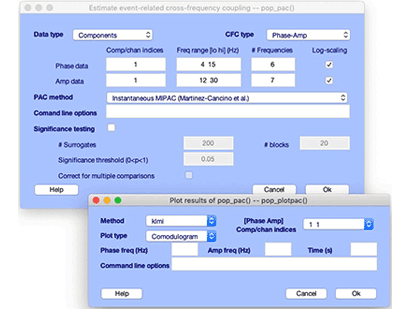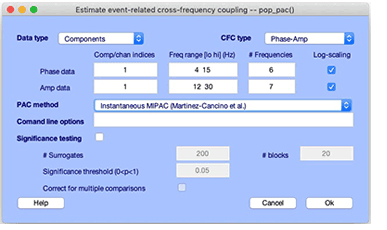The EEGLAB News #1
 PAC Tools - Interest in phase-amplitude coupling (PAC) has surged lately given the growing amount of evidence of its potential role in brain information processing and its differences in typical versus pathological conditions. At the time when the PAC Tools project was launched at SCCN, several PAC estimation methods were available but few could evaluate PAC temporal evolution across trials and latencies. To tackle this limitation was the initial motivation for our project. For this, we (Ramon Martinez-Cancino, Scott Makeig and Arnaud Delorme, in collaboration with Roberto Sotero of the University of Calgary) first developed a new PAC estimation approach using local mutual information (reported in a 2019 Neuroimage paper here) that proved able to provide a meaningful temporal description of the evolution of PAC in both simulated and real data.
PAC Tools - Interest in phase-amplitude coupling (PAC) has surged lately given the growing amount of evidence of its potential role in brain information processing and its differences in typical versus pathological conditions. At the time when the PAC Tools project was launched at SCCN, several PAC estimation methods were available but few could evaluate PAC temporal evolution across trials and latencies. To tackle this limitation was the initial motivation for our project. For this, we (Ramon Martinez-Cancino, Scott Makeig and Arnaud Delorme, in collaboration with Roberto Sotero of the University of Calgary) first developed a new PAC estimation approach using local mutual information (reported in a 2019 Neuroimage paper here) that proved able to provide a meaningful temporal description of the evolution of PAC in both simulated and real data.
 Next, we decided to build and release a unified and user-friendly platform for computing PAC in the EEGLAB framework. Currently, the toolbox features a readable GUI as well as command line access to the same function calls. Detailed documentation is oriented to make its use easy for users with all levels of expertise. The toolbox alpha version now available from its GitHub page currently comprises six PAC estimation methods: the Mean Vector Length Modulation Index (Canolty et al., 2006), the Kullback-Leibler Modulation Index (Tort et al., 2009), a Modulation Index based on a General Linear Model (Penny et al., 2008), ER-PAC (Voytek et al., 2010), and MIPAC / ER-MIPAC (Martinez-Cancino et al., 2019). Ongoing work is extending the toolbox capabilities to allow it to be applied directly to EEGLAB STUDY sets and to support faster MIPAC computation, both natively and by porting it to The Open EEGLAB Portal (see elsewhere in this issue).
Next, we decided to build and release a unified and user-friendly platform for computing PAC in the EEGLAB framework. Currently, the toolbox features a readable GUI as well as command line access to the same function calls. Detailed documentation is oriented to make its use easy for users with all levels of expertise. The toolbox alpha version now available from its GitHub page currently comprises six PAC estimation methods: the Mean Vector Length Modulation Index (Canolty et al., 2006), the Kullback-Leibler Modulation Index (Tort et al., 2009), a Modulation Index based on a General Linear Model (Penny et al., 2008), ER-PAC (Voytek et al., 2010), and MIPAC / ER-MIPAC (Martinez-Cancino et al., 2019). Ongoing work is extending the toolbox capabilities to allow it to be applied directly to EEGLAB STUDY sets and to support faster MIPAC computation, both natively and by porting it to The Open EEGLAB Portal (see elsewhere in this issue).